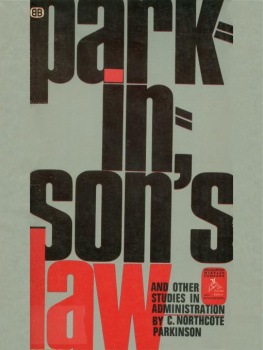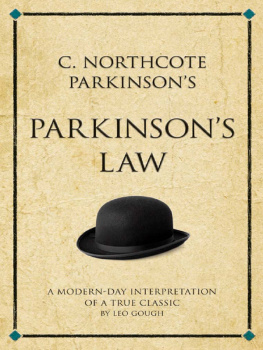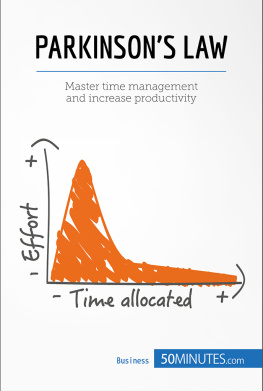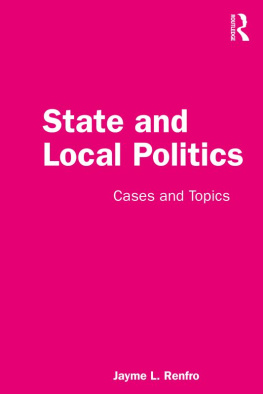Table of Contents
Everyone has heard of Parkinson's Lawbut how many can say what it means?
For those who can't, this book is a devastatingly accurate description of how administration really works in government, business, and every human group.
"Heaven forbid that students should cease to read books on the science of public or business administrationprovided only that these works are classified as fiction. Placed between the novels of Rider Haggard and H. G. Wells, intermingled with volumes about ape men and space ships, these textbooks could harm no one. Placed elsewhere, among works of reference, they can do more damage than might at first sight seem possible.... In Parkinson's Law, I have tried to provide a glimpse of reality."
C. Northcote Parkinson
PARKINSON'S
LAW
And other Studies in Administration
by C. Northcote Parkinson
ILLUSTRATED BY
Robert C. Osborn
BALLANTINE BOOKS NEW YORK
Copyright 1957 by C. Northcote Parkinson
All rights reserved including the right to reproduce this book or parts thereof in any form.
Library of Congress Catalog Card Number: 57-9981
This edition published by arrangement with Houghton Mifflin Company, Boston.
Printed in Canada.
Fust Ballantine Printing: August, 1964 Second Ballantine Printing: August, 1968
First Canadian Printing: September, 1964
Ballantine Books, Inc., 101 Fifth Avenue, New York, N. Y. 10003
Scanned, proofed, and converted by Kelzan!
4/14/2003 - Version 1.0
for Ann
PREFACE
TO THE VERY YOUNG, to schoolteachers, as also to those who compile textbooks about constitutional history, politics, and current affairs, the world is a more or less rational place. They visualize the election of representatives, freely chosen from among those the people trust. They picture the process by which the wisest and best of these become ministers of State. They imagine how captains of industry, freely elected by shareholders, choose for managerial responsibility those who have proved their ability in a humbler role. Books exist in which assumptions such as these are boldly stated or tacitly implied. To those, on the other hand, with any experience of affairs, these assumptions are merely ludicrous. Solemn conclaves of the wise and good are mere figments of the teacher's mind. It is salutary, therefore, if an occasional warning is uttered on this subject. Heaven forbid that students should cease to read books on the science of public or business administrationprovided only that these works are classified as fiction. Placed between the novels of Rider Haggard and H. G. Wells, intermingled with volumes about ape men and space ships, these textbooks could harm no one. Placed elsewhere, among works of reference, they can do more damage than might at first sight seem possible.
Dismayed to realize what other people suppose to be the truth about civil servants or building plans, I have occasionally tried to provide, for those interested, a glimpse of reality. The reader of discrimination will guess that these glimpses of the truth are based on no ordinary experience. In the expectation, moreover, that some readers will have less discrimination than others, I have been careful to hint, occasionally, casually, at the vast amount of research upon which my theories are founded. Let the reader picture to himself the wall charts, card index cabinets, calculating machines, slide rules, and reference works that may be thought the indispensable background to a study such as this. Let him then be assured that the reality dwarfs all his imagining, and that the truths here revealed are the work not merely of an admittedly gifted individual but of a vast and costly research establishment. An occasional reader may feel that more detailed description should have been given of the experiments and calculations upon which these theories rest. Let him reflect, however, that a volume so elaborate would take longer to read and cost more to buy.
While it is undeniable that each one of these essays embodies the results from years of patient investigation, it must not be supposed that all has yet been told. The recent discovery in a certain field of warfare that the number of the enemy killed varies inversely with the number of generals on one's own side has opened a whole new field of research. A new significance has been quite recently attributed to the illegibility of signatures, the attempt being made to fix the point in a successful executive career at which the handwriting becomes meaningless even to the executive himself. New developments occur almost daily, making it virtually certain that later editions of this work will quickly supersede the first.
I wish to thank the editors who have given permission to reprint certain of these essays. Pride of place must go to the editor of The Economist, the journal in which Parkinson's law was first revealed to mankind. To the same editor I am indebted for permission to reprint the essay on "Directors and Councils," as also that on "Pension Point." Certain of the other articles have also appeared previously in Harper's Magazine and The Reporter.
To the artist, Robert C. Osborn, I am deeply grateful for adding a touch of frivolity to a work that might otherwise have seemed too technical for the general reader. To the publishers I am indebted for their encouragement, without which I should have attempted little and achieved still less. Last of all, I place on record the gratitude I feel toward the higher mathematician with whose science the reader is occasionally blinded and to whom (but for other reasons) this book is dedicated.
C. NORTHCOTE PARKINSON
Singapore
1957
CONTENTS
PARKINSON'S LAW
1
PARKINSON'S LAW
OR
THE RISING PYRAMID
WORK EXPANDS SO AS TO FILL THE TIME AVAILABLE for its completion. General recognition of this fact is shown in the proverbial phrase "It is the busiest man who has time to spare." Thus, an elderly lady of leisure can spend the entire day in writing and dispatching a postcard to her niece at Bognor Regis. An hour will be spent in finding the postcard, another in hunting for spectacles, half an hour in a search for the address, an hour and a quarter in composition, and twenty minutes in deciding whether or not to take an umbrella when going to the mailbox in the next street. The total effort that would occupy a busy man for three minutes all told may in this fashion leave another person prostrate after a day of doubt, anxiety, and toil. Granted that work (and especially paperwork) is thus elastic in its demands on time, it is manifest that there need be little or no relationship between the work to be done and the size of the staff to which it may be assigned. A lack of real activity does not, of necessity, result in leisure. A lack of occupation is not necessarily revealed by a manifest idleness. The thing to be done swells in importance and complexity in a direct ratio with the time to be
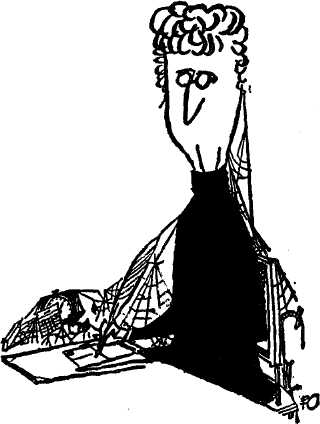
spent. This fact is widely recognized, but less attention has been paid to its wider implications, more especially in the field of public administration. Politicians and taxpayers have assumed (with occasional phases of doubt) that a rising total in the number of civil servants must reflect a growing volume of work to be done. Cynics, in questioning this belief, have imagined that the multiplication of officials must have left some of them idle or all of them able to work for shorter hours. But this is a matter in which faith and doubt seem equally misplaced. The fact is that the number of the officials and the quantity of the work are not related to each other at all. The rise in the total of those employed is governed by Parkinson's Law and would be much the same whether the volume of the work were to increase, diminish, or even disappear. The importance of Parkinson's Law lies in the fact that it is a law of growth based upon an analysis of the factors by which that growth is controlled.

